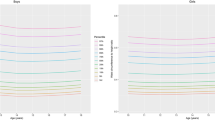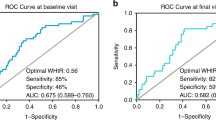Abstract
OBJECTIVE: Body mass index (BMI) was determined in a population of school students from three provinces of central Italy. Fasting serum leptin concentrations were assayed in a large number of subjects from the same area, to determine their distribution as plotted against the standard deviation score (z-score) of BMI.
DESIGN, SUBJECTS AND MEASUREMENTS: Height and weight were recorded from 31 170 subjects (16 175 male and 14 995 female), aged 3–18 y, to construct BMI charts of children and adolescents from central Italy. Percentiles and z-score were calculated using the LMS method of Cole. Serum leptin concentrations were assayed in 1929 subjects (996 male and 933 female) after overnight fasting.
RESULTS: BMI percentiles of central Italy were higher than those from standards of other European and USA populations. When plotted against the z-score of BMI, serum leptin values were distributed according to an exponential curve, showing a steep pattern and a wide distribution, as BMI values increased. The hypothesis of the existence of two subgroups, based on a different relation between leptin and BMI, was verified and a separation point between the two subgroups was identified using cluster analysis, discriminant analysis and a novel method developed by our group, hereafter referred to as ‘regression clustering’. This method allows identification of the value of the independent variable (z-score of BMI) which can be taken as a separation point. This analysis provided the best results and indicated the following separation points: central Italy standard, z-score=0.72 (76.4th percentile) for males and z-score=0.69 (75.5th percentile) for females; French standard (the one suggested for a European population by the European Childhood Obesity Group, ECOG), z-score=1.46 (92.8th percentile) for males and z-score=1.96 (97.5th percentile) for females. Similar but variable results were obtained when the same analysis was performed on serum leptin concentration, subdivided according to pubertal development (stage I, stage II–III, stage IV–V).
CONCLUSIONS: Children and adolescents from central Italy had greater BMI percentiles when compared to other European populations. Fasting serum leptin concentrations showed a distribution pattern related to z-score, thus allowing to identification of two different subgroups. The z-scores of BMI, identified as separation points, indicated a trend to leptin production by adipocytes that could be taken as indicators of significant increases of fat mass. This study proposes criteria and a statistical approach that could be useful in the identification of BMI cut-off values when screening children and adolescents for overweight.
This is a preview of subscription content, access via your institution
Access options
Subscribe to this journal
Receive 12 print issues and online access
$259.00 per year
only $21.58 per issue
Buy this article
- Purchase on Springer Link
- Instant access to full article PDF
Prices may be subject to local taxes which are calculated during checkout
Similar content being viewed by others
Author information
Authors and Affiliations
Rights and permissions
About this article
Cite this article
Falorni, A., Galmacci, G., Bini, V. et al. Fasting serum leptin levels in the analysis of body mass index cut-off values: are they useful for overweight screening in children and adolescents? A school population-based survey in three provinces of central Italy. Int J Obes 22, 1197–1208 (1998). https://doi.org/10.1038/sj.ijo.0800746
Received:
Revised:
Accepted:
Published:
Issue Date:
DOI: https://doi.org/10.1038/sj.ijo.0800746
Keywords
This article is cited by
-
Fetuin-A, adiposity-linked insulin resistance and responsiveness to an educational-based weight excess reduction program: a population-based survey in prepubertal schoolchildren
Endocrine (2017)
-
Body mass index, overweight and obesity among Kuwaiti intermediate school adolescents aged 10–14 years
European Journal of Clinical Nutrition (2004)
-
Ethnic differences in the relationship between fasting leptin and BMI in children
International Journal of Obesity (2004)
-
Identifying adolescents with high percentage body fat: a comparison of BMI cutoffs using age and stage of pubertal development compared with BMI cutoffs using age alone
European Journal of Clinical Nutrition (2003)
-
Epidemiology of overweight and obesity among school children and adolescents in three provinces of central Italy, 1993–2001: study of potential influencing variables
European Journal of Clinical Nutrition (2003)



